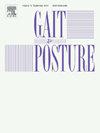执行功能域在健康年轻人双任务行走中认知和步态表现中的作用:一项初步研究
IF 2.2
3区 医学
Q3 NEUROSCIENCES
引用次数: 0
摘要
双任务行走(dual -task walking, DTW)通常用于评估EF,但大多数研究要么集中在运动任务难度上,要么集中在单个EF域的影响上。本研究通过检查DTW期间的多个EF域来解决这一差距。目的探讨不同执行功能域对健康青年双任务行走(DTW)的影响。方法:在这项横断面研究中,29名健康的年轻人单独和步行时完成了代表抑制、工作记忆和认知灵活性的任务。测量了EF任务的正确反应速度(CRS)和双任务成本(DTC)、步态速度和不同EF域的总体干扰。结果在单任务和双任务条件下,后向数字跨度任务(工作记忆)的CRS最高,而命名任务(认知灵活性)的CRS最慢。单步行走时步态表现最好,其次是行走时执行Stroop任务(WS)、后向数字跨度任务(WB)和命名任务(WN)。在WB期间观察到CRS的dtc显著升高,在WN期间观察到步态速度。WN表现出最高的总体干扰,而工作记忆表现出类似程度的认知和运动干扰。结论不同EF域对双任务行走的干扰程度不同。认知灵活性表现出最高的总体干扰,而工作记忆表现出相似水平的认知和运动干扰。这些发现对于选择评估和计划干预措施以提高双重任务能力是有价值的,特别是在有认知运动干扰风险的人群中。本文章由计算机程序翻译,如有差异,请以英文原文为准。
The role of executive function domains on cognitive and gait performance during dual task walking in healthy young adults: A preliminary study
Background
Dual-task walking (DTW) is commonly used to assess EF, yet most research has focused either on motor task difficulty or the influence of a single EF domain. This study addresses the gap by examining multiple EF domains during DTW.
Objective
This study investigated the impact of different executive function (EF) domains on dual-task walking (DTW) in healthy young adults.
Methods
In this cross-sectional study, 29 healthy young adults completed tasks representing inhibition, working memory, and cognitive flexibility, both individually and while walking. Correct response speed (CRS) for EF tasks and dual-task cost (DTC) for CRS, gait speed, and overall interference were measured across different EF domains.
Results
The backward digit span task (working memory) exhibited the highest CRS in both single-task and dual-task conditions, while the naming task (cognitive flexibility) had the slowest CRS. Gait performance was best during single walking, followed by walking while performing the Stroop task (WS), backward digit span task (WB), and naming task (WN). Significantly higher DTCs for CRS were observed during WB, and for gait speed during WN. WN demonstrated the highest overall interference, while working memory showed similar levels of cognitive and motor interference.
Conclusion
Different EF domains exert varying levels of interference on dual-task walking. Cognitive flexibility demonstrated the highest overall interference, while working memory showed similar levels of cognitive and motor interference.
Application
These findings are valuable for selecting assessments and planning interventions to improve dual-tasking abilities, particularly in populations at risk for cognitive-motor interference.
求助全文
通过发布文献求助,成功后即可免费获取论文全文。
去求助
来源期刊

Gait & posture
医学-神经科学
CiteScore
4.70
自引率
12.50%
发文量
616
审稿时长
6 months
期刊介绍:
Gait & Posture is a vehicle for the publication of up-to-date basic and clinical research on all aspects of locomotion and balance.
The topics covered include: Techniques for the measurement of gait and posture, and the standardization of results presentation; Studies of normal and pathological gait; Treatment of gait and postural abnormalities; Biomechanical and theoretical approaches to gait and posture; Mathematical models of joint and muscle mechanics; Neurological and musculoskeletal function in gait and posture; The evolution of upright posture and bipedal locomotion; Adaptations of carrying loads, walking on uneven surfaces, climbing stairs etc; spinal biomechanics only if they are directly related to gait and/or posture and are of general interest to our readers; The effect of aging and development on gait and posture; Psychological and cultural aspects of gait; Patient education.
 求助内容:
求助内容: 应助结果提醒方式:
应助结果提醒方式:


